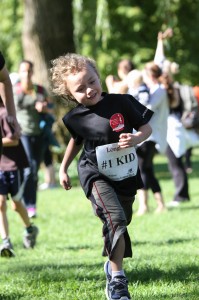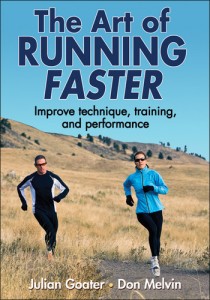Tomorrow, my 7-year-old son James will be trying out for his school cross-country team. As a runner, I am delighted. As the daughter of a former elite marathoner, I am downright thrilled. From wherever my dad is now, on the other side of the mortal divide, I’m sure he is smiling down on his grandson and namesake with pride.
Tomorrow’s try-out won’t be James’ first exposure to running. He ran his first race when he was just 5 years old. It was a 1km run for kids aged 5-12, meaning he was one of the youngest participants. He finished right around the middle of the pack, in seven minutes. It was a very good showing for a 5-year-old running his first race. About a year later, he ran another 1km race. He finished it in just under seven minutes, in spite of a large hill and the fact that there were hundreds of kids taking part. Then, this Spring, James made the relay team at his school.
So he is no stranger to athletics, and even at 7 years old, he kind of looks like a pro. Almost everyone who sees him run comments on how magnificent he looks. He has a beautiful natural form, a balletic fluidity that I can only envy. There is no awkward shuffling or ungainly loping. When James runs, he truly looks as if he was born to run. He is like Mother Nature’s model of perfect engineering.
What James has in pure physical technique, though, he lacks in strategy – at least where cross-country running is concerned. Strategy is something that is gained from experience, and he just doesn’t have enough of that yet. And so he makes the same mistake that I sometimes make, even with all of the miles I have on my legs: the mistake of taking off like a rocket and then running out of steam.
I have been trying to counsel him ahead of tomorrow’s try-out.
“Start slower,” I say, “And then you’ll be able to keep going for longer.”
But it’s so hard for him to understand. To a 7-year-old’s literal mind, it’s hard to reconcile the idea of going more slowly with the reality of racing. And my gut is telling me to go easy on the advice and give him enough space to discover for himself what his true running style is.
It is easy for me to be emotionally vested in the outcome of my son’s athletic efforts, because it creates a link that unites him with the grandfather he never got to know. But I need to remember that he is not doing this for me. He is doing it for himself. He made the decision, without any prior discussion with me, to go for this try-out. It would not be right for me to start having expectations, or to behave like the scary moms in shows like Toddlers And Tiaras.
I have already equipped James as best I can. I have advised him on strategy and pacing, and now it is up to him to go out and find his own way in his athletic endeavours. Maybe he’ll burn out in the try-outs and discover that he is better suited to sprinting. Or maybe he will find his rhythm and earn a place on the cross-country team.
No matter what happens, this is not my journey of discovery, but James’. I hope that he can learn from his failures and embrace the successes.
I already know that he has the legs of an athlete. Now it’s up to him (with Mommy close by, of course) to develop his athlete’s heart.
This is an original post by Kirsten Doyle. Photo credit to the author.












